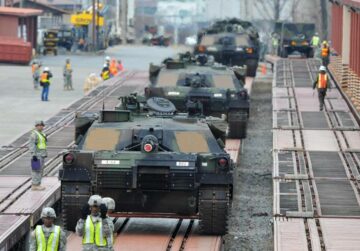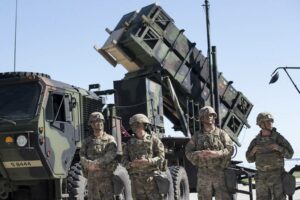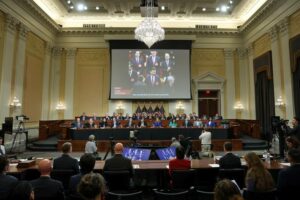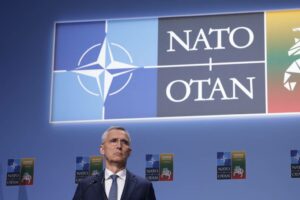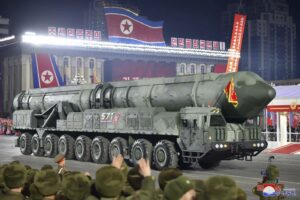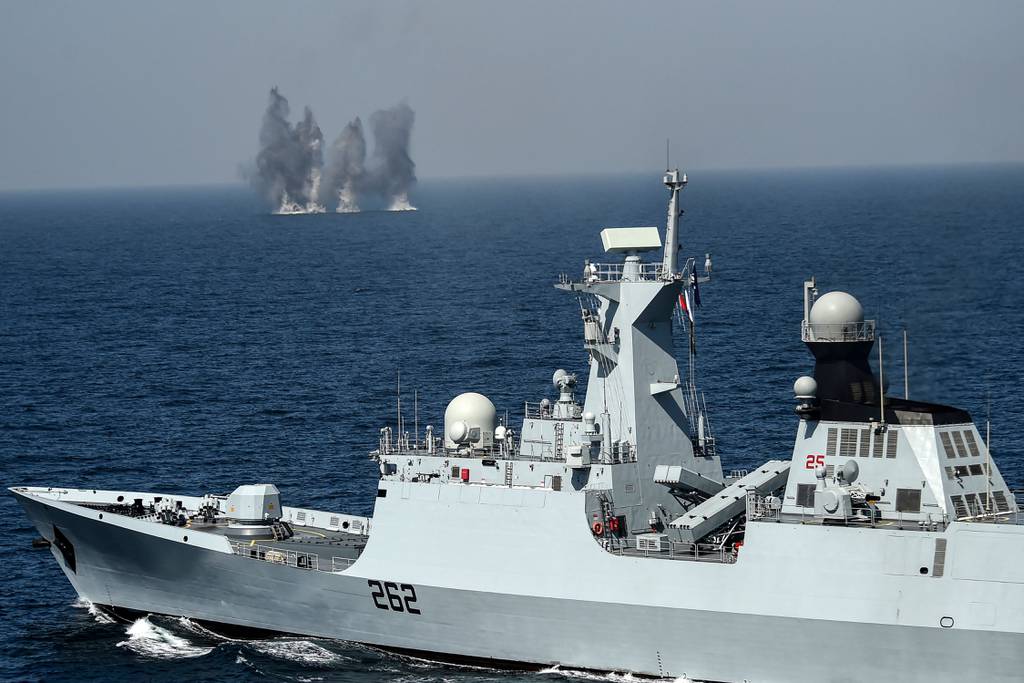
ISLAMABAD — The Pakistani government has requested a nearly 16% increase to its defense budget, despite a standoff with the International Monetary Fund over economic stagflation.
The government unveiled its request for 1.804 trillion rupees (U.S. $6.267 billion) for fiscal 2023-2024 — a 15.7% increase over the revised total for fiscal 2022-2023 — on June 9.
The IMF is withholding a $1.1 billion tranche of the remaining $2.2 billion from a total $6.7 billion bailout package agreed to in 2019. The pause in funds is due to Pakistan’s failure to meet obligations set out by the IMF, according to the organization.
The funding would help Pakistan avoid default on its foreign debts, as the State Bank of Pakistan has less than $4 billion in foreign exchange reserves. However, the country is required to make external loan repayments of $22 billion in FY23-24.
Relations between Finance Minister Ishaq Dar and the IMF are dire. The IMF’s resident representative for Pakistan, Esther Perez Ruiz, on June 14 criticized the budget request, which included offers of tax amnesty and failed to widen the tax base.
Making cuts to defense spending could prove difficult in Pakistan, which is facing its nuclear-armed archrival India and is combatting the Pakistani Taliban, also known as Tehreek-e-Taliban Pakistan, or TTP. A Feb. 13 report by the U.N. Security Council, cited members states as having found the Taliban’s 2021 takeover of neighboring Afghanistan has “emboldened TTP to escalate attacks against Pakistan.”
Asked by Defense News if Pakistan could defeat the TTP without the full cooperation of the Afghan Taliban, Safdar Hussain, a joint director and research analyst at the Pak Institute for Peace Studies think tank, said that “ ‘defeating’ or ‘full elimination’ may not be the right term in case of the TTP, as it is not a conventional army.” Rather, the TTP “can be weakened to a greater extent with or without the help of Afghan Taliban,” he explained.
However, he added, “the cooperation of the Afghan Taliban is vital to cope with the TTP threat because even if Pakistan ensures that the group is completely eliminated from Pakistani soil, it can continue operating from Afghanistan and make cross-border incursions and attacks, and will try to regroup on this side of border whenever it find an opportunity.”
What’s in the draft budget?
Pakistan’s FY22-23 defense budget increased from a planned 1.57 trillion rupees to 1.59 trillion rupees.
The FY23-24 defense budget request is 1.7% of gross domestic product — an economic indicator that has recently dropped — while the FY22-23 fund was 1.87% of GDP. Currency devaluation against the U.S. dollar, coupled with record-high inflation, complicates making a direct comparison in dollar terms.
Some spending efforts, such as defense procurement, are excluded from the new defense budget draft.
An additional 280 billion rupees was earmarked for the military’s development programs, among other efforts, with 100 million rupees going toward project management for a new shipyard in Gwadar, and 1.9 billion rupees for infrastructure upgrades at Karachi Shipyard and Engineering Works.
The latest proposal would see the Army receive 824.6 billion rupees, the Air Force get 368.5 billion rupees and the Navy secure 188.2 billion rupees.
An amount of 442 billion rupees is for operating expenses, and 461 billion rupees would go toward domestic and imported arms and ammunition.
The government did not detail planned spending on its nuclear deterrent program.
Is it worth it?
Tuaha Adil, a research economist at the Policy Research Institute of Market Economy, said the amount Pakistan plans to spend is concerning. However, he told Defense News, at 12.4% of total expenditure and 1.7% of GDP, the FY23-24 figures show a decline compared to FY22-23 figures of 14.3% and 1.87% respectively.
Pointing to the TTP threat in particular, he said defense spending must rise, even at the expense of development.
He added that the “underlying cause” of the country’s economic woes “is the recurring fiscal deficits” caused by the misallocation of resources, untargeted subsidies, the inability of the governments to cut losses by privatizing financially unstable state-owned enterprises, and a failure to improve the domestic taxation system.
Defense economics analyst Fida Muhammad Khan said the military will fund critical projects, such as the JF-17 Thunder fighter program, come what may. And he dismissed calls for defense cuts as politically motivated and ill informed.
“Missile systems and nuclear programs will be in most cases be business as usual. This is not the first time that we have been hit by an economic crisis”, according to Khan, who lectures at the Pakistan Institute of Development Economics think tank. “The nominal value is high, but in real terms there have been many times in history when Pakistan has faced such situations. And in all those bad times, the defense budgets and critical defense programs have remained safe from budget cuts.”
Nevertheless, he told Defense News, “the economic situation will have a negative impact. We can expect delays in equipment delivery, and also a discouragement of acquisition of new weapon systems.”
That might hit projects such as the Navy’s Sea Sultan maritime patrol aircraft, or foreign acquisition efforts. Consequently, he said, the military should make “major cutbacks on recurring expenditures, and divert those funds towards arms/equipment acquisition and modernization campaigns.”
He also stressed the need to increase defense exports, especially to Africa, and recommended institutions such as Pakistan Aeronautical Complex offer maintenance, repair and overhaul services to foreign customers — including to the Taliban. Khan considers this a realist approach for Pakistan to earn revenue, while also helping the Taliban combat the Islamic State group.
If Pakistan is forced to make spending cuts, the government should look elsewhere, he added, while criticizing the size of social safety net programs, such as the Benazir Income Support Program, which has a 455 billion rupee budget — more than that of the Air Force — and poorly performing state-owned enterprises, such as the national airline and railways.
Given the TTP threat and India’s defense spending, “the current budgetary provision is less than required,” Khan concluded.
Even if Pakistan restructures its debts, as the finance minister has suggested, it’s unclear if that would impact defense spending, Adil said, noting that Pakistan’s public debt is 63% domestic and 37% external.
“It is crucial for the government to exercise fiscal prudence and implement structural reforms to avert the crisis,” Adil said.
But Khan insisted the “defense budget is not determined by the economic situation. Its primary determinant is the security situation of the country and its national interests, including the protection of its sovereignty.”
Usman Ansari is the Pakistan correspondent for Defense News.
- SEO Powered Content & PR Distribution. Get Amplified Today.
- PlatoData.Network Vertical Generative Ai. Empower Yourself. Access Here.
- PlatoAiStream. Web3 Intelligence. Knowledge Amplified. Access Here.
- PlatoESG. Automotive / EVs, Carbon, CleanTech, Energy, Environment, Solar, Waste Management. Access Here.
- BlockOffsets. Modernizing Environmental Offset Ownership. Access Here.
- Source: https://www.defensenews.com/global/asia-pacific/2023/06/22/pakistan-unveils-increased-defense-budget-imf-decries-spending-plan/
- :has
- :is
- :not
- $6.7 billion
- 1
- 100
- 12
- 13
- 14
- 15%
- 17
- 2019
- 2021
- 2022
- 2023
- 23
- 7
- 70
- 8
- 804
- 9
- a
- According
- acquisition
- added
- Additional
- AFGHANISTAN
- africa
- against
- AIR
- Air Force
- aircraft
- airline
- All
- also
- ammunition
- among
- amount
- an
- analyst
- and
- approach
- ARE
- arms
- Army
- AS
- At
- attack
- Attacks
- avoid
- Bad
- bailout
- Bank
- base
- BE
- because
- been
- between
- Billion
- border
- budget
- Budgets
- business
- but
- by
- Calls
- Campaigns
- CAN
- capable
- carry
- carrying
- case
- cases
- caused
- cited
- City
- combat
- come
- compared
- comparison
- completely
- complex
- Compound
- concerning
- concluded
- Consequently
- considers
- continue
- conventional
- cooperation
- could
- Council
- country
- country’s
- coupled
- crisis
- critical
- cross-border
- crucial
- Currency
- Current
- Customers
- Cut
- cuts
- Debt
- Decline
- Default
- Defense
- delays
- delivery
- Despite
- detail
- determined
- Devaluation
- Development
- DID
- difficult
- dire
- direct
- Director
- displayed
- Dollar
- Domestic
- draft
- dropped
- due
- during
- earn
- Economic
- Economics
- Economist
- economy
- efforts
- eliminated
- elsewhere
- Engineering
- ensures
- enterprises
- equipment
- especially
- Even
- exchange
- Exchange Reserves
- excluded
- Exercise
- expect
- expenses
- explained
- exports
- extent
- external
- faced
- facing
- Failed
- Failure
- Feb
- Figures
- finance
- FINANCE MINISTER
- financially
- Find
- First
- first time
- Fiscal
- following
- For
- Force
- foreign
- foreign exchange
- found
- from
- full
- fund
- funding
- funds
- GDP
- get
- Go
- going
- Government
- Governments
- greater
- gross
- Group
- Have
- having
- he
- help
- helping
- High
- history
- Hit
- Hospital
- However
- HTTPS
- if
- images
- IMF
- Impact
- implement
- improve
- in
- inability
- included
- Including
- Income
- Increase
- increased
- india
- Indicator
- inflation
- informed
- Infrastructure
- Institute
- institutions
- interests
- International
- international monetary fund
- Islamic
- Islamic State
- IT
- ITS
- joint
- jpg
- june
- known
- latest
- least
- lectures
- less
- loan
- Look
- losses
- maintenance
- make
- Making
- management
- many
- March
- Maritime
- Market
- May..
- Meet
- Members
- might
- Military
- million
- modernization
- Monetary
- more
- most
- motivated
- must
- National
- nearly
- Need
- negative
- net
- New
- news
- noting
- nuclear
- obligations
- of
- offer
- Offers
- Officer
- on
- operating
- Opportunity
- or
- organization
- Other
- out
- over
- Overhaul
- package
- Pakistan
- particular
- pause
- peace
- People
- performing
- plan
- planned
- plans
- plato
- Plato Data Intelligence
- PlatoData
- Police
- policy
- politically
- primary
- procurement
- Product
- Program
- Programs
- project
- project management
- projects
- proposal
- protection
- Prove
- provision
- public
- railways
- rather
- real
- receive
- recently
- recommended
- recurring
- remained
- remaining
- repair
- repayments
- representative
- request
- requested
- required
- research
- reserves
- Resources
- respectively
- revenue
- right
- Rise
- s
- safe
- Safety
- Said
- SEA
- secure
- security
- see
- Services
- set
- seven
- should
- show
- side
- situation
- situations
- Size
- Social
- soil
- sovereignty
- spend
- Spending
- stagflation
- State
- state-owned
- States
- structural
- studies
- such
- Suicide
- sultan
- support
- system
- Systems
- takeover
- TALIBAN
- tank
- tax
- Taxation
- term
- terms
- than
- that
- The
- The State
- There.
- think
- think tank
- this
- those
- threat
- time
- times
- to
- Total
- toward
- towards
- Trillion
- try
- u.s.
- u.s. dollar
- UN
- unveiled
- Unveils
- upgrades
- value
- via
- vital
- was
- we
- were
- What
- when
- whenever
- which
- while
- WHO
- will
- with
- without
- works
- worth
- would
- zephyrnet



